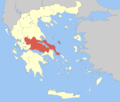Delphi
| Δελφοί | |
.jpg) The Delphic Tholos, seen from above. | |
 Shown within Greece | |
| Location | Phocis, Greece |
|---|---|
| Coordinates | 38°28′53″N 22°30′06″E / 38.4812634°N 22.5016871°E |
| Type | Settlement |
| History | |
| Cultures | Ancient Greece |
| Official name | Archaeological Site of Delphi |
| Type | Cultural |
| Criteria | i, ii, iii, iv and vi |
| Designated | 1987 (12th session) |
| Reference no. | 393 |
| State Party | Greece |
| Region | Europe and North America |
Delphi (/ˈdɛlfaɪ/ or /ˈdɛlfi/; Greek: Δελφοί, [ðelˈfi])[1] is famous as the ancient sanctuary that grew rich as the seat of the oracle that was consulted on important decisions throughout the ancient classical world. Moreover, it was considered as the navel (or centre) of the world by the Greeks as represented by the Omphalos.
It occupies an impressive site on the south-western slope of Mount Parnassus overlooking the coastal plain to the south and the valley of Phocis. It is now an extensive archaeological site and the modern town is nearby.
It is recognised by UNESCO as a World Heritage Site in having had a phenomenal influence in the Ancient world, as evidenced by the rich monuments built there by most of the important ancient Greek city-states, demonstrating their fundamental Hellenic unity.
Origins and location

The site of Delphi is located in upper central Greece, on multiple plateaux/terraces along the slope of Mount Parnassus, and includes the Sanctuary of Apollo, the site of the ancient Oracle. This semicircular spur is known as Phaedriades, and overlooks the Pleistos Valley.
In myths dating to the classical period of Ancient Greece (510-323 BC), the site of Delphi was believed to be determined by Zeus when he sought to find the centre of his "Grandmother Earth" (Ge, Gaea, or Gaia). He sent two eagles flying from the eastern and western extremities, and the path of the eagles crossed over Delphi where the omphalos, or navel of Gaia was found.[2]
Earlier myths [3]include traditions that Pythia, or the Delphic oracle, already was the site of an important oracle in the pre-classical Greek world (as early as 1400 BC) and, rededicated from about 800 BC, when it served as the major site during classical times for the worship of the god Apollo. Apollo was said to have slain Python, a "drako" a serpent or a dragon who lived there and protected the navel of the Earth.[4] "Python" (derived from the verb πύθω (pythō),[5] "to rot") is claimed by some to be the original name of the site in recognition of Python which Apollo defeated.[6] The Homeric Hymn to Delphic Apollo recalled that the ancient name of this site had been Krisa.[7] Others relate that it was named Pytho and that Pythia, the priestess serving as the oracle, was chosen from their ranks by a group of priestesses who officiated at the temple.
At the settlement site in Delphi, which was a post-Mycenaean settlement of the late 9th century, there is a steady increase in artifacts from the last quarter of the 8th century BC. Pottery and bronze work as well as tripod dedications continue in a steady stream, in comparison to Olympia. Neither the range of objects nor the presence of prestigious dedications proves that Delphi was a focus of attention for a wide range of worshippers, but the large quantity of high value goods, found in no other mainland sanctuary, certainly encourages that view.
Apollo's sacred precinct in Delphi was a panhellenic sanctuary, where every four years, starting in 586 BC[8] athletes from all over the Greek world competed in the Pythian Games, one of the four panhellenic (or stephanitic) games, precursors of the Modern Olympics. The victors at Delphi were presented with a laurel crown (stephanos) which was ceremonially cut from a tree by a boy who re-enacted the slaying of the Python.[8] Delphi was set apart from the other games sites because it hosted the mousikos agon, musical competitions.[6]
These Pythian Games rank second among the four stephanitic games chronologically and in importance.[8] These games, though, were different from the games at Olympia in that they were not of such vast importance to the city of Delphi as the games at Olympia were to the area surrounding Olympia. Delphi would have been a renowned city whether or not it hosted these games; it had other attractions that led to it being labeled the "omphalos" (navel) of the earth, in other words, the centre of the world.[9]
In the inner hestia ("hearth") of the Temple of Apollo, an eternal flame burned. After the battle of Plataea, the Greek cities extinguished their fires and brought new fire from the hearth of Greece, at Delphi; in the foundation stories of several Greek colonies, the founding colonists were first dedicated at Delphi.[10]
Dedication to Apollo
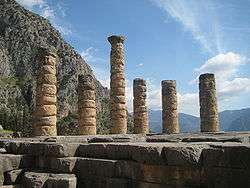
The name Delphoi comes from the same root as δελφύς delphys, "womb" and may indicate archaic veneration of Gaia at the site.[11][12] Apollo is connected with the site by his epithet Δελφίνιος Delphinios, "the Delphinian". The epithet is connected with dolphins (Greek δελφίς,-ῖνος) in the Homeric Hymn to Apollo (line 400), recounting the legend of how Apollo first came to Delphi in the shape of a dolphin, carrying Cretan priests on his back. The Homeric name of the oracle is Pytho (Πυθώ).[13] Another legend held that Apollo walked to Delphi from the north and stopped at Tempe, a city in Thessaly, to pick laurel (also known as bay tree) which he considered to be a sacred plant. In commemoration of this legend, the winners at the Pythian Games received a wreath of laurel picked in the Temple.
Delphi became the site of a major temple to Phoebus Apollo, as well as the Pythian Games and the famous prehistoric oracle. Even in Roman times, hundreds of votive statues remained, described by Pliny the Younger and seen by Pausanias. Carved into the temple were three phrases: γνῶθι σεαυτόν (gnōthi seautón = "know thyself") and μηδέν άγαν (mēdén ágan = "nothing in excess"), and Ἑγγύα πάρα δ'ἄτη (eggýa pára d'atē = "make a pledge and mischief is nigh"),[14] In antiquity, the origin of these phrases was attributed to one or more of the Seven Sages of Greece by authors such as Plato[15] and Pausanias.[16] Additionally, according to Plutarch's essay on the meaning of the "E at Delphi"—the only literary source for the inscription—there was also inscribed at the temple a large letter E.[17] Among other things epsilon signifies the number 5. However, ancient as well as modern scholars have doubted the legitimacy of such inscriptions.[18] According to one pair of scholars, "The actual authorship of the three maxims set up on the Delphian temple may be left uncertain. Most likely they were popular proverbs, which tended later to be attributed to particular sages."[19]
According to the Homeric-hymn to the Pythian Apollo, Apollo shot his first arrow as an infant which effectively slew the serpent Pytho, the son of Gaia, who guarded the spot. To atone the murder of Gaia's son, Apollo was forced to fly and spend eight years in menial service before he could return forgiven. A festival, the Septeria, was held every year, at which the whole story was represented: the slaying of the serpent, and the flight, atonement, and return of the god.[20]
The Pythian Games took place every four years to commemorate Apollo's victory.[20] Another regular Delphi festival was the "Theophania" (Θεοφάνεια), an annual festival in spring celebrating the return of Apollo from his winter quarters in Hyperborea. The culmination of the festival was a display of an image of the gods, usually hidden in the sanctuary, to worshippers.[21]
The "Theoxenia" was held each summer, centred on a feast for "gods and ambassadors from other states". Myths indicate that Apollo killed the chthonic serpent Python, Pythia in older myths, but according to some later accounts his wife, Pythia, who lived beside the Castalian Spring. Some sources say it is because Python had attempted to rape Leto while she was pregnant with Apollo and Artemis.
This spring flowed toward the temple but disappeared beneath, creating a cleft which emitted chemical vapors that caused the Oracle at Delphi to reveal her prophecies. Apollo killed Python but had to be punished for it, since she was a child of Gaia. The shrine dedicated to Apollo was originally dedicated to Gaia and shared with Poseidon.[20] The name Pythia remained as the title of the Delphic Oracle.
Erwin Rohde wrote that the Python was an earth spirit, who was conquered by Apollo, and buried under the Omphalos, and that it is a case of one deity setting up a temple on the grave of another.[22] Another view holds that Apollo was a fairly recent addition to the Greek pantheon coming originally from Lydia . The Etruscans coming from northern Anatolia also worshipped Apollo, and it may be that he was originally identical with Mesopotamian Aplu, an Akkadian title meaning "son", originally given to the plague God Nergal, son of Enlil. Apollo Smintheus (Greek Απόλλων Σμινθεύς), the mouse killer[23] eliminates mice, a primary cause of disease, hence he promotes preventive medicine.
Oracle of Delphi
Delphi is perhaps best known for the oracle of the Pythia in the form of the sibyl or priestess at the sanctuary dedicated to Apollo. According to Aeschylus in the prologue of the Eumenides, the oracle had origins in prehistoric times and the worship of Gaea, a view echoed by H.W. Parke.[24]
One tale of the sanctuary's discovery states that a goatherd, who grazed his flocks on Parnassus, one day observed his goats playing with great agility upon nearing a chasm in the rock; the goatherd noticing this held his head over the chasm causing the fumes to go to his brain; throwing him into a strange trance.[25]
Apollo spoke through his oracle. She had to be an older woman of blameless life chosen from among the peasants of the area. Alone in an enclosed inner sanctum (Ancient Greek adyton - "do not enter") she sat on a tripod seat over an opening in the earth (the "chasm"). According to legend, when Apollo slew Python its body fell into this fissure and fumes arose from its decomposing body. Intoxicated by the vapours, the sibyl would fall into a trance, allowing Apollo to possess her spirit. In this state she prophesied. The oracle could not be consulted during the winter months, for this was traditionally the time when Apollo would live among the Hyperboreans. Dionysus would inhabit the temple during his absence.[26]
While in a trance the Pythia "raved" – probably a form of ecstatic speech – and her ravings were "translated" by the priests of the temple into elegant hexameters. It has been speculated that the ancient writers, including Plutarch who had worked as a priest at Delphi, were correct in attributing the oracular effects to the sweet-smelling pneuma (Ancient Greek for breath, wind or vapour) escaping from the chasm in the rock. That exhalation could have been high in the known anaesthetic and sweet-smelling ethylene or other hydrocarbons such as ethane known to produce violent trances. Though this theory remains debatable the authors put up a detailed answer to their critics.[27][28][29]
Ancient sources describe “laurel”, or Laurus nobilis, being used by the priestess, in order to inspire her prophecies. Several alternative plant candidates have been suggested including Cannabis, Hyoscyamus, Rhododendron and Oleander. Harissis claims that a review of contemporary toxicological literature indicates that oleander causes symptoms similar to those of the Pythia, and his study of ancient texts shows that oleander was often included under the term “laurel”. The Pythia may have chewed oleander leaves and inhaled their smoke prior to her oracular pronouncements and sometimes dying from the toxicity. The toxic substances of oleander resulted in symptoms similar to those of epilepsy, the “sacred disease,” which may have been seen as the possession of the Pythia by the spirit of Apollo.[30]
The Delphic Oracle exerted considerable influence throughout the Greek world, and she was consulted before all major undertakings: wars, the founding of colonies, and so forth. She also was respected by the Greek-influenced countries around the periphery of the Greek world, such as Lydia, Caria, and even Egypt.
The oracle was also known to the early Romans. Rome's seventh and last king, Lucius Tarquinius Superbus, after witnessing a snake near his palace, sent a delegation including two of his sons to consult the oracle.[31]
In 83 BC a Thracian tribe raided Delphi, burned the temple, plundered the sanctuary and stole the "unquenchable fire" from the altar. During the raid, part of the temple roof collapsed.[32] The same year, the Temple was severely damaged by an earthquake. Thus the Oracle fell in decay and the surrounding area became impoverished. The sparse local population led to difficulties in filling the posts required. The Oracle's credibility waned due to doubtful predictions.
The oracle relatively flourished again during the rule of emperor Hadrian, who is believed to have visited the oracle twice. Also, Hadrian offered complete autonomy to the city.[32] By the 4th century, Delphi had acquired the status of a city.[33] Constantine the Great looted several monuments, most notably the Tripod of Plataea, which he used to decorate his new capital, Constantinople.
Despite the rise of Christianity across the Roman Empire, the oracle remained a religious centre throughout the 4th century, and the Pythian Games continued to be held at least until 424 AD;[33] however, the decline continued. The attempt of the emperor Julian to revive polytheism did not survive his reign.[32] Excavations have revealed a large three-aisled basilica in the city, as well as traces of a church building in the sanctuary's gymnasium.[33] The site was abandoned in the 6th or 7th centuries, although a single bishop of Delphi is attested in an episcopal list of the late 8th/early 9th centuries.[33]
History
Ancient Delphi
Delphi was since a very early stage a place of worship for Gaia, the mother goddess connected with fertility. The town started to have a pan-Hellenic relevance as both a shrine and an oracle in the 7th century BC. Initially under the control of Phocaean settlers based in nearby Kirra (currently Itea), Delphi was reclaimed by the Athenians during the First Sacred War (597–585 BC). The conflict resulted in the consolidation of the Amphictyonic League, which had both a military and a religious function revolving around the protection of the Temple of Apollo. This shrine was destroyed by fire in 548 BC and then fell under the control of the Alcmaeonids banned from Athens. In 449–448 BC, the Second Sacred War (happened in the wider context of the First Peloponnesian War fought between the Peloponnesian League led by Sparta and the Delian-Attic League led by Athens) resulted in the Phocians having the control of Delphi and the management of the Pythian Games. In 356 BC the Phocians under Philomelos captured and sacked Delphi, leading to the Third Sacred War (356–346 BC), which ended with the defeat of the former and the rise of Macedon under the reign of Philip II. This led to the Fourth Sacred War (339 BC), which culminated in the Battle of Chaeronea (338 BC) and the establishment of Macedonian rule over Greece. In Delphi, Macedonian rule was superseded by the Aetolians in 279 BC, when a Gallic invasion was repelled, and by the Romans in 191 BC. The site was sacked by Lucius Cornelius Sulla in 86 BC, during the Mithridatic Wars, and by Nero in 66 AD. Even though subsequent Roman emperors of the Flavian dynasty contributed towards to the restoration of the site, it gradually lost importance until it was shut by Theodosius I in 381 AD.[34]
Ottoman Delphi
Time and natural disasters added to the picture of desolation of the once glorious place, and during the Ottoman period the village of Kastri was founded on the site.
Buildings and structures
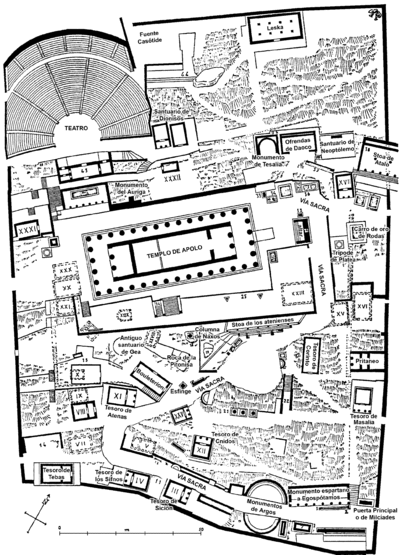
Occupation of the site at Delphi can be traced back to the Neolithic period with extensive occupation and use beginning in the Mycenaean period (1600–1100 BC). Most of the ruins that survive today date from the most intense period of activity at the site in the 6th century BC.[35]
Temple of Apollo
The ruins of the Temple of Delphi visible today date from the 4th century BC, and are of a peripteral Doric building. It was erected on the remains of an earlier temple, dated to the 6th century BC which itself was erected on the site of a 7th-century BC construction attributed to the architects Trophonios and Agamedes.[36]
The 6th-century BC temple was named the "Temple of Alcmonidae" in tribute to the Athenian family who funded its reconstruction following a fire, which had destroyed the original structure. The new building was a Doric hexastyle temple of 6 by 15 columns. This temple was destroyed in 375 BC by an earthquake. The pediment sculptures are a tribute to Praxias and Androsthenes of Athens. Of a similar proportion to the second temple it retained the 6 by 15 column pattern around the stylobate.[36] Inside was the adyton, the centre of the Delphic oracle and seat of Pythia. The temple had the statement "Know thyself", one of the Delphic maxims, carved into it (and some modern Greek writers say the rest were carved into it), and the maxims were attributed to Apollo and given through the oracle and/or the Seven Sages of Greece ("know thyself" perhaps also being attributed to other famous philosophers). The monument was partly restored during 1938(?)–1300.
The temple survived until AD 390, when the Roman emperor Theodosius I silenced the oracle by destroying the temple and most of the statues and works of art in the name of Christianity.[37] The site was completely destroyed by zealous Christians in an attempt to remove all traces of Paganism.[37]
Amphictyonic Council
The Amphictyonic Council was a council of representatives from six Greek tribes that controlled Delphi and also the quadrennial Pythian Games. They met biannually and came from Thessaly and central Greece. Over time, the town of Delphi gained more control of itself and the council lost much of its influence.
Treasuries
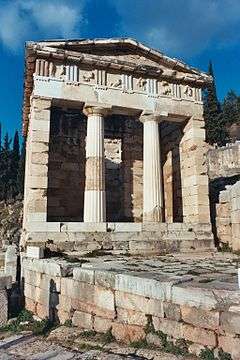
From the entrance of the site, continuing up the slope almost to the temple itself, are a large number of votive statues, and numerous so-called treasuries. These were built by many of the Greek city states to commemorate victories and to thank the oracle for her advice which was thought to have contributed to those victories. These buildings held the rich offerings made to Apollo; these were frequently a "tithe" or tenth of the spoils of a battle. The most impressive is the now-restored Athenian Treasury, built to commemorate their victory at the Battle of Marathon in 490 BC.
The Siphnian Treasury was dedicated by the city of Siphnos whose citizens gave a tithe of the yield from their silver mines until the mines came to an abrupt end when the sea flooded the workings.
One of the largest of the treasuries was that of Argos. Built in the late Doric period, the Argives took great pride in establishing their place amongst the other city states. Completed in 380BC, the treasury draws inspiration mostly from the Temple of Hera located in the Argolis, the acropolis of the city. However, recent analysis of the Archaic elements of the treasury suggest that its founding preceded this.
Other identifiable treasuries are those of the Sikyonians, the Boeotians and the Thebans.
Altar of the Chians
Located in front of the Temple of Apollo, the main altar of the sanctuary was paid for and built by the people of Chios. It is dated to the 5th century BC by the inscription on its cornice. Made entirely of black marble, except for the base and cornice, the altar would have made a striking impression. It was restored in 1920.[38]
Stoa of the Athenians
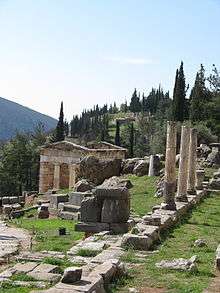
The stoa leads off north-east from the main sanctuary. It was built in the Ionic order and consists of seven fluted columns, unusually carved from single pieces of stone (most columns were constructed from a series of discs joined together). The inscription on the stylobate indicates that it was built by the Athenians after their naval victory over the Persians in 478 BC, to house their war trophies. The stoa was attached to the existing Polygonal Wall.[39]
Sibyl rock
The Sibyl rock is a pulpit-like outcrop of rock between the Athenian Treasury and the Stoa of the Athenians upon the sacred way which leads up to the temple of Apollo in the archaeological area of Delphi. It is claimed to be where an ancient Sibyl pre-dating the Pythia of Apollo sat to deliver her prophecies.
Theatre
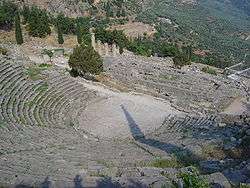
The ancient theatre at Delphi was built further up the hill from the Temple of Apollo giving spectators a view of the entire sanctuary and the valley below. [40] It was originally built in the 4th century BC but was remodeled on several occasions, particularly in 160/159 B.C. at the expenses of king Eumenes II of Pergamon and in 67 A.D. on the occasion of emperor Nero's visit. [41] The koilon (cavea) leans against the natural slope of the mountain whereas its eastern part overrides a little torrent which led the water of the fountain Cassotis right underneath the temple of Apollo. The orchestra was initially a full circle with a diameter measuring 7 meters. The rectangular scene building ended up in two arched openings, of which the foundations are preserved today. Access to the theatre was possible through the parodoi, i.e. the side corridors. On the support walls of the parodoi are engraved large numbers of manumission inscriptions recording fictitious sales of the slaves to the god. The koilon was divided horizontally in two zones via a corridor called diazoma. The lower zone had 27 rows of seats and the upper one only 8. Six radially arranged stairs divided the lower part of the koilon in seven tiers. The theatre could accommodate about 4,500 spectators.[42] On the occasion of Nero's visit to Greece in 67 A.D. various alterations took place. The orchestra was paved and delimited by a parapet made of stone. The proscenium was replaced by a low pedestal, the pulpitum; its façade was decorated with scenes from Hercules' myth in relief. Further repairs and transformations took place in the 2nd century A.D. Pausanias mentions that these were carried out under the auspices of Herod Atticus. In antiquity, the theatre was used for the vocal and musical contests which formed part of the programme of the Pythian Games in the late Hellenistic and Roman period.[43] The theatre was abandoned when the sanctuary declined in Late Antiquity. After its excavation and initial restoration it hosted theatrical performances during the Delphic Festivals organized by A. Sikelianos and his wife, Eva Palmer, in 1927 and in 1930. It has recently been restored again as the serious landslides posed a grave threat for its stability for decades.[44] [45]
Tholos
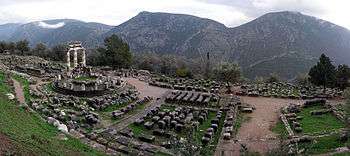
The Tholos at the sanctuary of Athena Pronoia (Ἀθηνᾶ Πρόνοια, "Athena of forethought") is a circular building that was constructed between 380 and 360 BC. It consisted of 20 Doric columns arranged with an exterior diameter of 14.76 meters, with 10 Corinthian columns in the interior.
The Tholos is located approximately a half a mile (800 m) from the main ruins at Delphi (at 38°28′49″N 22°30′28″E / 38.480172°N 22.507886°E). Three of the Doric columns have been restored, making it the most popular site at Delphi for tourists to take photographs. Vitruvius (vii, introduction) notes Theodorus of Samos as the architect of the Round Building which is at Delphi.
Gymnasium
The gymnasium, which is half a mile away from the main sanctuary, was a series of buildings used by the youth of Delphi. The building consisted of two levels: a stoa on the upper level providing open space, and a palaestra, pool and baths on lower floor. These pools and baths were said to have magical powers, and imparted the ability to communicate to Apollo himself.[38]
Stadium

The stadium is located further up the hill, beyond the via sacra and the theatre. It was originally built in the 5th century BC but was altered in later centuries. The last major remodelling took place in the 2nd century AD under the patronage of Herodes Atticus when the stone seating was built and (arched) entrance. It could seat 6500 spectators and the track was 177 metres long and 25.5 metres wide.[46]
Hippodrome
It was at the Pythian games that prominent political leaders, such as Cleisthenes, tyrant of Sikyon, and Hieron, tyrant of Syracuse, competed with their chariots. The hippodrome where these events took place was referred to by Pindar,[47] and this monument was sought by archaeologists for over two centuries.
Its traces have recently been found at Gonia in the plain of Krisa in the place where the original stadium was sited.[48]
Polygonal wall
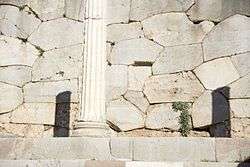
The retaining wall was built to support the terrace housing the construction of the second temple of Apollo in 548 BC. Its name is taken from the polygonal masonry of which it is constructed. At a later date, from 200 BC onwards, the stones were inscribed with the manumission contracts of slaves who were consecrated to Apollo. Approximately a thousand manumissions are recorded on the wall.[49]
Castalian spring
The sacred spring of Delphi lies in the ravine of the Phaedriades. The preserved remains of two monumental fountains that received the water from the spring date to the Archaic period and the Roman, with the latter cut into the rock.
Athletic statues
Delphi is famous for its many preserved athletic statues. It is known that Olympia originally housed far more of these statues, but time brought ruin to many of them, leaving Delphi as the main site of athletic statues.[50] Kleobis and Biton, two brothers renowned for their strength, are modeled in two of the earliest known athletic statues at Delphi. The statues commemorate their feat of pulling their mother's cart several miles to the Sanctuary of Hera in the absence of oxen. The neighbors were most impressed and their mother asked Hera to grant them the greatest gift. When they entered Hera's temple, they fell into a slumber and never woke, dying at the height of their admiration, the perfect gift.[50]
The Charioteer of Delphi is another ancient relic that has withstood the centuries. It is one of the best known statues from antiquity. The charioteer has lost many features, including his chariot and his left arm, but he stands as a tribute to athletic art of antiquity.[50]
Architectural traditions
Ancient tradition accounted for four temples that successively occupied the site before the 548/7 BC fire, following which the Alcmaeonids built a fifth. The poet Pindar celebrated the Alcmaeonid's temple in Pythian 7.8-9 and he also provided details of the third building (Paean 8. 65-75). Other details are given by Pausanias (10.5.9-13) and the Homeric Hymn to Apollo (294 ff.). The first temple was said to have been constructed out of olive branches from Tempe. The second was made by bees out of wax and wings but was miraculously carried off by a powerful wind and deposited among the Hyperboreans. The third, as described by Pindar, was created by the gods Hephaestus and Athena, but its architectural details included Siren-like figures or 'Enchantresses', whose baneful songs eventually provoked the Olympian gods to bury the temple in the earth (according to Pausanias, it was destroyed by earthquake and fire). In Pindar's words, addressed to the Muses:
- Muses, what was its fashion, shown
- By the skill in all arts
- Of the hands of Hephaestus and Athena?
- Of bronze the walls, and of bronze
- Stood the pillars beneath,
- But of gold were six Enchantresses
- Who sang above the eagle.
- But the sons of Cronus
- Opened the earth with a thunderbolt
- And hid the holiest of all things made.
- Away from their children
- And wives, when they hung
- Their lives on the honey-hearted words.[51]
The fourth temple was said to have been constructed from stone by Trophonius and Agamedes.[52]
The Delphi Archaeological Museum
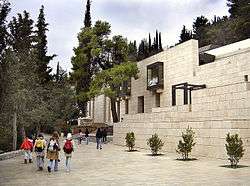
The Delphi Archaeological Museum is at the foot of the main archaeological complex, on the east side of the village, and on the north side of the main road. The museum houses an impressive collection associated with ancient Delphi, including the earliest known notation of a melody, the famous Charioteer, golden treasures discovered beneath the Sacred Way, and fragments of reliefs from the Siphnian Treasury. Immediately adjacent to the exit (and overlooked by most tour guides) is the inscription that mentions the Roman proconsul Gallio.
Entries to the museum and to the main complex are separate and chargeable, and a reduced rate ticket gets entry to both. There is a small cafe, and a post office by the museum.
Excavations
The site had been occupied by the village of Kastri since medieval times. Before a systematic excavation of the site could be undertaken, the village had to be relocated but the residents resisted. The opportunity to relocate the village occurred when it was substantially damaged by an earthquake, with villagers offered a completely new village in exchange for the old site. In 1893 the French Archaeological School removed vast quantities of soil from numerous landslides to reveal both the major buildings and structures of the sanctuary of Apollo and of Athena Pronoia along with thousands of objects, inscriptions and sculptures.[38]
The site is now an archaeological one, and a very popular tourist destination. It is easily accessible from Athens as a day trip, and is often combined with the winter sports facilities available on Mount Parnassus, as well as the beaches and summer sports facilities of the nearby coast of Phocis.
The site is also protected as a site of extraordinary natural beauty, and the views from it are also protected: no industrial artefacts are to be seen from Delphi other than roads and traditional architecture residences (for example high voltage power lines and the like are routed so as to be invisible from the area of the sanctuary).
Depiction of Delphi in art
From the 16th century onwards, West Europe developed an interest in Delphi. In the mid-15th century Strabo was first translated in Latin. The earliest depictions of Delphi were totally imaginary, created by the German N. Gerbel, who published in 1545 a text based on the map of Greece by N. Sofianos. The ancient sanctuary was depicted as a fortified city. The first travelers with archaeological interests, apart from the precursor Cyriacus of Ancona, were the British George Wheler and the French Jacob Spon, who visited Greece in a joint expedition in 1675-76. They published their impressions separately. In Wheler's "Journey into Greece", published in 1682, a sketch of the region of Dephi appeared, where the settlement of Kastri and some ruins were depicted. The illustrations in Spon's publication "Voyage d'Italie, de Dalmatie, de Grèce et du Levant, 1678" are considered original and groundbreaking.
Travelers continued to visit Delphi throughout the 19th century and published their books which contained diaries, sketches, views of the site as well as pictures of coins. The illustrations often reflected the spirit of romanticism, as evident by the works of Otto Magnus von Stackelberg, where, apart from the landscapes (La Grèce. Vues pittoresques et topographiques, Paris 1834) are depicted also human types (Costumes et usages des peuples de la Grèce moderne dessinés sur les lieux, Paris 1828). The philhellene painter W. Williams has comprised the landscape of Delphi in his themes (1829). important personalities such as F.Ch.-H.-L. Pouqueville, W.M. Leake, Chr. Wordsworth and Lord Byron are amongst the most important visitors of Delphi.
After the foundation of the modern Greek state, the press becomes also interested in these travelers. Thus "Ephemeris" writes (17/03/1889): “In the "Revues des Deux Mondes" Paul Lefaivre published his memoirs from an excursion to Delphi. The French author relates in a charming style his adventures on the road, praising particularly the ability of an old woman to put back in its place the dismantled arm of one of his foreign traveling companions, who had fallen off the horse. In Arachova the Greek type is preserved intact. The men are rather athletes than farmers, built for running and wrestling, particularly elegant and slender under their mountain gear. Only briefly does he refer to the antiquities of Delphi, but he refers to a pelasgian wall 80 meters long, on which innumerable inscriptions are carved, decrees, conventions, manumissions".
Gradually the first travelling guides appeared. The revolutionary "pocket" books invented by Karl Baedeker, accompanied by maps useful for visiting archaeological sites such as Delphi (1894) and the informed plans, the guides became practical and popular. The photographic lens revolutionized the way of depicting the landscape and the antiquities, particularly from 1893 onwards, when the systematic excavations of the French Archaeological School started. However, artists such as Vera Willoughby, continued to be inspired by the landscape.
Delphic themes inspired several graphic artists. Besides the landscape, Pythia/Sibylla become an illustration subject even on Tarot cards.[53] A famous example constitutes Michelangelo's Delphic Sibyl (1509),[54] the 19th-century German engraving Oracle of Apollo at Delphi, as well as the most recent The Oracle of Delphi, inc on paper, by the Swedish Malin Lind.[55] Modern artists are inspired also by the Delphic Maxims. Examples of such works are displayed in the "Sculpture park of the European Cultural Center of Delphi" and in exhibitions taking place at the Archaeological Museum of Delphi.
Delphi in literature
Delphi inspired literature as well. In 1814 W. Haygarth, friend of Lord Byron, refers to Delphi in his work "Greece, a Poem". In 1888 Charles Marie René Leconte de Lisle published his lyric drama L’Apollonide, accompanied by music by Franz Servais. More recent French authors used Delphi as a source of inspiration such as Yves Bonnefoy (Delphes du second jour) or Jean Sullivan (nickname of Joseph Lemarchand) in L'Obsession de Delphes (1967), but also Rob MacGregor's Indiana Jones and the Peril at Delphi (1991).
The presence of Delphi in Greek literature is very intense. Poets such as Kostis Palamas (The Delphic Hymn, 1894), Kostas Karyotakis (Delphic festival, 1927), Nikephoros Vrettakos (return from Delphi, 1957), Yannis Ritsos (Delphi, 1961–62) and Kiki Dimoula (Gas omphalos and Appropriate terrain 1988), to mention only the most renowned ones. Angelos Sikelianos wrote The Dedication (of the Delphic speech) (1927), the Delphic Hymn (1927) and the tragedy Sibylla (1940), whereas in the context of the Delphic idea and the Delphic festivals he published an essay titled "The Delphic union" (1930). The nobelist George Seferis wrote an essay under the title "Delphi", comprised in the book "Dokimes".
The importance of Delphi for the Greeks is significant. The site has been recorded on the collective memory and have been expressed through tradition. Nikolaos Politis, the famous Greek ethnographer, in his Studies on the life and language of the Greek people - part A, offers two examples from Delphi: a) the priest of Apollo (176) When Christ was born a priest of Apollo was sacrificing below the monastery of Panayia, on the road of Livadeia, on a site called Logari. Suddenly he abandoned the sacrifice and says to the people: "in this moment was born the son of God, who will be very powerful, like Apollo, but then Apollo will beat him". He didn't have time to finish his speech and a thunder came down and burnt him, opening the rock nearby into two. [p. 99] b)The Mylords (108) The Mylords are not Christians, because nobody ever saw them cross themselves. They originate from the old pagan inhabitants of Delphi who kept their property in castle called Adelphi, named after the two brother princes who built it. When Christ and his mother came to the site, and all people around converted to Christianity they thought that they should better leave; thus the Mylords left for the West and took all their belongings with them. The Mylords come here now and worship theses stones. [p. 59]
Modern Delphi
| Delphi Δελφοί | |
|---|---|
 Delphi | |
|
Location within the region 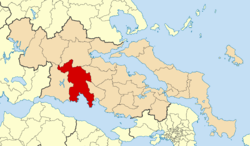 | |
| Coordinates: 38°29′N 22°30′E / 38.483°N 22.500°ECoordinates: 38°29′N 22°30′E / 38.483°N 22.500°E | |
| Country | Greece |
| Administrative region | Central Greece |
| Regional unit | Phocis |
| Government | |
| • Mayor | Athanasios Panagiotopoulos (since 2014) |
| Area | |
| • Municipality | 1,121.7 km2 (433.1 sq mi) |
| • Municipal unit | 73.13 km2 (28.24 sq mi) |
| Elevation | 632 m (2,073 ft) |
| Population (2011)[56] | |
| • Municipality | 26,716 |
| • Municipality density | 24/km2 (62/sq mi) |
| • Municipal unit | 1,767 |
| • Municipal unit density | 24/km2 (63/sq mi) |
| Community[56] | |
| • Population | 1,024 (2011) |
| Time zone | EET (UTC+2) |
| • Summer (DST) | EEST (UTC+3) |
| Vehicle registration | ΑΜ |
Town
Modern Delphi is situated immediately west of the archaeological site and hence is a popular tourist destination. It is on a major highway linking Amfissa along with Itea and Arachova. There are many hotels and guest houses in the town, and many taverns and bars. The main streets are narrow, and often one-way. The E4 European long distance path passes through the east end of the town. In addition to the archaeological interest, Delphi attracts tourists visiting the Parnassus Ski Center and the popular coastal towns of the region.
In the Middle Ages a town called Kastri was built on the archaeological site. The residents had used the marble columns and structures as support beams and roofs for their improvised houses, a usual way of rebuilding towns that were partially or totally destroyed, especially after the earthquake in 1580, which demolished several towns in Phocis. In 1893 archaeologists from the École française d'Athènes finally located the actual site[57] of ancient Delphi and the village was moved to a new location, west of the site of the temples.
Municipality
The municipality Delphi was formed at the 2011 local government reform by the merger of the following 8 former municipalities, that became municipal units:[58]
The municipality has an area of 1121.671 km2, the municipal unit 73.126 km2.[59] The administrative seat of the municipality is in the largest town, Amfissa. The total population of the municipality is 32,263. The town Delphi has a population of 2,373 people while the population of the municipal unit of Delphi, including Chrisso (ancient Krissa), is 3,511.[58]
See also
- Franz Weber (activist) - made an honorary citizen of Delphi in 1997
- Delphi Archaeological Museum
- Aristoclea, Delphic priestess of the 6th century BC, said to have been tutor to Pythagoras
- Greek art
- List of traditional Greek place names
Photo gallery of modern Delphi
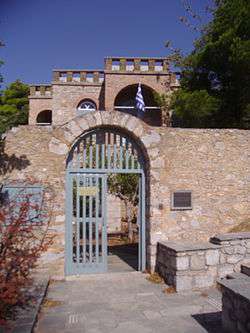 House of Angelos Sikelianos
House of Angelos Sikelianos Saint Nicolas church
Saint Nicolas church Town hall
Town hall.jpg) Building and view into valley
Building and view into valley.jpg) Valley and road sign
Valley and road sign.jpg) Entrance flags
Entrance flags.jpg) Fence and valley
Fence and valley Olive trees and water aqueduct in Delphi valley
Olive trees and water aqueduct in Delphi valley
Notes
- ↑ In English, the name Delphi is pronounced either as /ˈdɛlfaɪ/ or, in a more the Greek-like manner, as /ˈdɛlfiː/. The Greek spelling transliterates as "Delphoi" (with an o); dialectal forms include Belphoi — Aeolian form — and Dalphoi — Phocian form—, as well as other Greek dialectal varieties.
- ↑ Graves, Robert (1993), "The Greek Myths: Complete Edition" (Penguin, Harmondsworth)
- ↑ Pausanias 10.12.1
- ↑ Konstaninou, Ioanna "Delphi: the Oracle and its Role in the Political and Social Life of the Ancient Greeks" (Hannibal Publishing House, Athens)
- ↑ Entry πύθω at LSJ
- 1 2 Miller, p. 95
- ↑ Hymn to Pythian Apollo, l. 254–74: Telphousa recommends to Apollo to build his oracle temple at the site of "Krisa below the glades of Parnassus".
- 1 2 3 Miller, p.96
- ↑ Miller, pp. 96–7
- ↑ Burkert 1985, pp. 61, 84.
- ↑ Fontenrose, Joseph, The Delphic Oracle: Its Responses and Operations, with a Catalogue of Responses (1978). pp. 3–4. "Such was its prestige that most Hellenes after 500 BCE placed its foundation in the earliest days of the world: before Apollo took possession, they said, Ge (Earth) (Gaia) and her daughter Themis had spoken oracles at Pytho. Such has been the strength of the tradition that many historians and others have accepted as historical fact the ancient statement that Ge and Themis spoke oracles before it became Apollo's establishment. Yet nothing but the myth supports this statement. In the earliest account that we have of the Delphic Oracle's beginnings, the story found in the Homeric Hymn to Apollo (281–374), there was no Oracle before Apollo came and killed the great she-dragon, Pytho's only inhabitant. This was apparently the Delphic myth of the sixth century".
- ↑ Farnell, Lewis Richard, The Cults of the Greek States, v.III, pp. 8–10, onwards. "The earth is the abode of the dead, therefore the earth-deity has power over the ghostly world: the shapes of dreams, which often foreshadowed the future, were supposed to ascend from the world below, therefore the earth-deity might acquire an oracular function, especially through the process of incubation, in which the consultant slept in a holy shrine with his ear upon the ground. That such conceptions attached to Gaia is shown by the records of her cults at Delphi, Athens, and Aegae. A recently discovered inscription speaks of a temple of Ge at Delphi. ... As regards Gaia, we also can accept it. It is confirmed by certain features in the latter Delphic divination, and also by the story of the Python."
- ↑ Odyssey, VIII, 80
- ↑ Plato, Charmides 164d–165a.
- ↑ Plato, Protagoras 343a–b at the Perseus Project.
- ↑ Pausanias, Description of Greece, Phocis and Ozolian Locri, 10.24.1 at the Perseus Project.
- ↑ Hodge, A. Trevor. "The Mystery of Apollo's E at Delphi," American Journal of Archaeology, Vol. 85, No. 1. (Jan., 1981), pp. 83–84.
- ↑ H. Parke and D. Wormell, The Delphic Oracle, (Basil Blackwell, 1956), vol. 1, pp. 387–389.
- ↑ Parke & Wormell, p. 389.
- 1 2 3 Cf. Seyffert, Dictionary of Classic Antiquities, article on "Delphic Oracle"
- ↑ James Hall, A History of Ideas and Images in Italian Art, pp 70–71, 1983, John Murray, London, ISBN 0719539714
- ↑ Rodhe, E (1925), "Psyche: The Cult of Souls and the Belief in Immortality among the Greeks", trans. from the 8th edn. by W. B. Hillis (London: Routledge & Kegan Paul, 1925; reprinted by Routledge, 2000). p.97.
- ↑ Entry: σμινθεύς at Henry George Liddell, Robert Scott, A Greek-English Lexicon
- ↑ Herbert William Parke, The Delphic Oracle, v.1, p.3. "The foundation of Delphi and its oracle took place before the times of recorded history. It would be foolish to look for a clear statement of origin from any ancient authority, but one might hope for a plain account of the primitive traditions. Actually this is not what we find. The foundation of the oracle is described by three early writers: the author of the Homeric Hymn to Apollo, Aeschylus in the prologue to the Eumenides, and Euripides in a chorus in the Iphigeneia in Tauris. All three versions, instead of being simple and traditional, are already selective and tendentious. They disagree with each other basically, but have been superficially combined in the conventional version of late classical times." Parke goes on to say, "This version [Euripides] evidently reproduces in a sophisticated form the primitive tradition which Aeschylus for his own purposes had been at pains to contradict: the belief that Apollo came to Delphi as an invader and appropriated for himself a previously existing oracle of Earth. The slaying of the serpent is the act of conquest which secures his possession; not as in the Homeric Hymn, a merely secondary work of improvement on the site. Another difference is also noticeable. The Homeric Hymn, as we saw, implied that the method of prophecy used there was similar to that of Dodona: both Aeschylus and Euripides, writing in the fifth century, attribute to primeval times the same methods as used at Delphi in their own day. So much is implied by their allusions to tripods and prophetic seats." Continuing on p.6, "Another very archaic feature at Delphi also confirms the ancient associations of the place with the Earth goddess. This was the Omphalos, an egg-shaped stone which was situated in the innermost sanctuary of the temple in historic times. Classical legend asserted that it marked the 'navel' (Omphalos) or center of the Earth and explained that this spot was determined by Zeus who had released two eagles to fly from opposite sides of the earth and that they had met exactly over this place". On p.7 he writes further, "So Delphi was originally devoted to the worship of the Earth goddess whom the Greeks called Ge, or Gaia. Themis, who is associated with her in tradition as her daughter and partner or successor, is really another manifestation of the same deity: an identity which Aeschylus himself recognized in another context. The worship of these two, as one or distinguished, was displaced by the introduction of Apollo. His origin has been the subject of much learned controversy: it is sufficient for our purpose to take him as the Homeric Hymn represents him – a northern intruder – and his arrival must have occurred in the dark interval between Mycenaean and Hellenic times. His conflict with Ge for the possession of the cult site was represented under the legend of his slaying the serpent."
- ↑ William Godwin (1876). "Lives of the Necromancers". p. 11.
- ↑ See (e.g.) Fearn 2007, 182.
- ↑ Spiller, Henry A; Hale, John R; De Boer, Jelle Z (2002). "The Delphic Oracle: A Multidisciplinary Defense of the Gaseous Vent Theory" (PDF). Clinical Toxicology. 40 (2): 189–196. PMID 12126193.
- ↑ John Roach (2001-08-14). "Delphic Oracle's Lips May Have Been Loosened by Gas Vapors". National Geographic. Retrieved March 8, 2007.
- ↑ Spiller, Henry; De Boer, Jella; Hale, John R; Chanton, Jeffery (2008). "Gaseous emissions at the site of the Delphic Oracle: Assessing the ancient evidence". Clinical Toxicology. 46 (5): 487–488. doi:10.1080/15563650701477803. PMID 18568810. Retrieved 27 November 2016.
- ↑ Harissis, Haralampos V (2014). "A Bittersweet Story: The True Nature of the Laurel of the Oracle of Delphi". Perspect Biol Med. 57 (3): 351–360. doi:10.1353/pbm.2014.0032. PMID 25959349. Retrieved 27 November 2016.
- ↑ Livy, Ab urbe condita, 1.56
- 1 2 3 Lampsas Giannis, Dictionary of the Ancient World (Lexiko tou Archaiou Kosmou), Vol. I, Athens, Domi Publications, 1984, pp. 761-762
- 1 2 3 4 Gregory, Timothy E. (1991). "Delphi". In Kazhdan, Alexander. Oxford Dictionary of Byzantium. London and New York: Oxford University Press. p. 602. ISBN 978-0-19-504652-6.
- ↑ Grecia. Guida d'Europa (in Italian). Milano: Touring Club Italiano. 1977. p. 126.
- ↑ Delphi Archaeological Site, Ancient-Greece.org
- 1 2 Sakoulas, Thomas. "Temple of Apollo at Delphi". Ancient-Greece.org. Retrieved 28 November 2016.
- 1 2 Trudy Ring, Robert M. Salkin, Sharon La Bod, International Dictionary of Historic Places: Southern Europe; Page 185;
- 1 2 3 Delphi, Hellenic Ministry of Culture.
- ↑ Stoa of the Athenians at Ashes2Art.
- ↑ Bommelaer, J.-F., Laroche, D., Guide de Delphes: Le site, Paris 1991, pp. 207-212
- ↑ Delphi Theater at Ancient-Greece.org.
- ↑ Bommelaer, J.-F. «Das Theater», in Maas, M. (ed), Delphi. Orakel am Nabel der Welt,Karlsruhe 1996, pp.95-105
- ↑ Mulliez, D., “Οι πυθικοί αγώνες. Οι μαρτυρίες των επιγραφών”, in Κολώνια, Ρ. (ed.), Αρχαία Θέατρα της Στερεάς Ελλάδας, Διάζωμα, Αθήνα 2013, 147-154
- ↑ http://www.diazoma.gr/200-Stuff-06-Theatres/DataSheet_Delfon.pdf
- ↑ Χλέπα, Ε.-Α., Παπαντωνόπουλος, Κ., «Τεκμηρίωση και αποκατάσταση του αρχαίου θεάτρου Δελφών», in Κολώνια, Ρ. (ed.), Αρχαία Θέατρα της Στερεάς Ελλάδας, Διάζωμα, Αθήνα 2013, 173-198
- ↑ Delphi Stadium at Ancient-Greece.org.
- ↑ Pindar: Pythian 3
- ↑ https://archaeologynewsnetwork.blogspot.co.uk/2013/03/hippodrome-of-ancient-delphi-located.html#z06LKygAcwlc7Lmv.97
- ↑ Manumission Wall at Ashes2Art; Manumission of female slaves at Delphi at attalus.org.
- 1 2 3 Miller, p. 98
- ↑ Pindar, Paean 8.65-75, translated by C.M. Bowra, Pindar, Oxford University Press (2000 reprint), p. 373-74
- ↑ C.M. Bowra, Pindar, Oxford University Press (2000 reprint), p. 373-75
- ↑
- ↑ ], το Consulting the Oracle του John William Waterhouse (1882), the Priestess of Delphi by John Collier (1891), the work Consulting the Oracle του John William Waterhouse (1882)
- ↑
- 1 2 "Απογραφή Πληθυσμού - Κατοικιών 2011. ΜΟΝΙΜΟΣ Πληθυσμός" (in Greek). Hellenic Statistical Authority.
- ↑ (see link)
- 1 2 Kallikratis law Greece Ministry of Interior (Greek)
- ↑ "Population & housing census 2001 (incl. area and average elevation)" (PDF) (in Greek). National Statistical Service of Greece.
References
- Broad, William J. The Oracle: Ancient Delphi and the Science Behind its Lost Secrets, New York : Penguin, 2006. ISBN 1-59-420081-5.
- Burkert, Walter, Greek Religion 1985.
- Connelly, Joan Breton, Portrait of a Priestess: Women and Ritual in Ancient Greece, Princeton University Press, 2007. ISBN 0691127468
- Dempsey, T., Reverend, The Delphic oracle, its early history, influence and fall, Oxford: B.H. Blackwell, 1918.
- Farnell, Lewis Richard, The Cults of the Greek States, in five volumes, Clarendon Press, 1896–1909. (Cf. especially, volume III and volume IV on the Pythoness and Delphi).
- Fearn, David. Bacchylides: Politics, Performance, Poetic Tradition. Oxford University Press, 2007. ISBN 9780199215508
- Fontenrose, Joseph Eddy, The Delphic oracle, its responses and operations, with a catalogue of responses, Berkeley: University of California Press, 1978. ISBN 0520033604
- Fontenrose, Joseph Eddy, Python; a study of Delphic myth and its origins, New York, Biblio & Tannen, 1974. ISBN 081960285X
- Goodrich, Norma Lorre, Priestesses, New York: F. Watts, 1989. ISBN 0531151131
- Guthrie, William Keith Chambers, The Greeks and their Gods, 1955.
- Hall, Manly Palmer, The Secret Teachings of All Ages, 1928. Ch. 14 cf. Greek Oracles,www, PRS
- Harissis H.V. 2015. “A Bittersweet Story: The True Nature of the Laurel of the Oracle of Delphi” Perspectives in Biology and Medicine. Volume 57, Number 3, Summer 2014, pp. 295-298.
- Herodotus, The Histories
- Homeric Hymn to Pythian Apollo
- Manas, John Helen, Divination, ancient and modern, New York, Pythagorean Society, 1947.
- Parke, Herbert William, History of the Delphic Oracle, 1939.
- Plutarch "Lives"
- Rohde, Erwin, Psyche, 1925.
- Seyffert, Oskar, "Dictionary of Classical Antiquities", London: W. Glaisher, 1895.
- Spiller, Henry A., John R. Hale, and Jelle Z. de Boer. "The Delphic Oracle: A Multidisciplinary Defense of the Gaseous Vent Theory." Clinical Toxicology 40.2 (2000) 189–196.
- West, Martin Litchfield, The Orphic Poems, 1983. ISBN 0-19-814854-2.
- Stephen G. Miller, Ancient Greek Athletics, New Haven and London: Yale University Press, 2004
Further reading
- Morgan, Catherine, Athletes and Oracles: The Transformation of Olympia and Delphi in the Eighth Century BCE (Cambridge; New York: Cambridge University Press, 1990). ISBN 0-521-37451-0
- Scott, Michael, Delphi: A History of the Center of the Ancient World (Princeton, NJ: Princeton University Press, 2014). ISBN 978-0-691-15081-9
- Temple, Robert, "Fables, Riddles, and Mysteries of Delphi", Proceedings of 4th Philosophical Meeting on Contemporary Problems, No 4, 1999 (Athens, Greece) In Greek and English.
External links
| Wikivoyage has a travel guide for Delphi. |
| Wikimedia Commons has media related to Delphi. |
General
- Delphic Oracle on In Our Time at the BBC. (listen now)
- Official website of the archaeological site
- Official website of the Museum
- Michael Scott. "Delphi: The Bellybutton of the Ancient World". BBC 4. Retrieved 23 Nov 2010. Missing or empty
|series=(help) - Restoration drawings of Delphi
- Homepage of the modern municipality (English) (Greek)
- Hellenic Ministry of Culture: Delphi
- C. Osborne, "A Short detour to Delphi and the Sibyls"
- Eloise Hart, "The Delphic oracle"
- III JUNIOR DELPHIC GAMES 2007 Baguio City, Philippines – November 10 to 15
- International Delphic Council
- ASHES2ART Digital Delphi
- Delphi-Help - первая помощь по Delphi (RUSSIA)
- European Cultural Centre of Delphi
- The ¨ E ¨ of Delphi and the "Know thyself"
- Images of the ancient sanctuary of Delphi
Geology of Delphi
- John R. Hale, et al., "Questioning the Delphic Oracle: When science meets religion at this ancient Greek site, the two turn out to be on better terms than scholars had originally thought", in Scientific American August 2003
- John Roach, "Delphic Oracle's Lips May Have Been Loosened by Gas Vapors" in National Geographic news, August 2001
- Geology of Delphi
- The New York Times, March 19, 2002: "Fumes and Visions Were Not a Myth for Oracle at Delphi"
- A Geological Companion to Greece and the Aegean by Michael and Reynold Higgins, Cornell University Press, 1996

